Food allergy testing
Do you have symptoms that make you think you could have a food allergy? Allergic reactions to food are often mild but can potentially be life-threatening in some people. Many people who think they might be allergic to a certain food might actually have an intolerance to it rather than an allergy. If you have reactions to certain foods, it’s important to find out if it’s caused by food intolerance or food allergies. You could start with a food allergy test.
We've made testing for allergies simple. Discover what your body reacts to with our easy to use home-to-lab test. The Home Allergy Test can be a first step to finding out if food allergies might be causing your allergic reaction. The test kit includes everything you need to take a small blood sample at home. Then all you have to do is send your blood sample to our partner lab for food allergy testing and analysis. There's a prepaid envelope included in the test kit. You’ll receive your comprehensive and reliable allergen testing results within two weeks.
About the food allergy test
The most common type of food allergy is known as Immunoglobulin E (IgE) mediated food allergy. IgE is an antibody produced by our immune system in an allergic reaction. The immune system produces IgE specific to the trigger it’s trying to fight. Identifying specific IgE is a science-based process to pinpoint potential allergens.
The Home Allergy Test can detect specific antibodies in your blood. It's a comprehensive food allergy test. It analyses your body’s reaction to more than 150 food allergen extracts and components as well as a wide range of other allergens.
Allergen extracts have been taken from what is called a whole allergen source. For example, a peanut. Allergen components are individual proteins in the allergen source. For example, the proteins of the peanut that may cause a reaction.
The Home Allergy Test has the advantage of convenience. There’s no need to wait around for an appointment as you can take the blood test in the comfort of your own home.
Everything you need to collect a small blood sample from your fingertip is included in the test kit. There's a step-by-step guide to help you and you can also watch our how-to video. It doesn't take long. Give yourself about 30 minutes to collect your sample.
Then all you need to do is post your blood sample to our partner lab for analysis. Before you send your blood sample to the lab, you’ll need to activate your test online. This creates your unique account. Your food allergy test results will be available in your online account within two weeks.
Order your food allergy test today.
Many allergens, one test
The Home Allergy Test tests and analyses your body’s reaction to 294 different allergens including:- Pollen 59
- Pets 25
- Insect stings 10
- Moulds & yeasts 13
- Foods 154
- Other 14
Symptoms of food allergy
An allergic reaction happens when your body treats a harmless substance as a threat. And your immune system produces an unnecessary response to the trigger. Food allergy symptoms can range from mild to severe. But it can be unpredictable. A food that once triggered mild symptoms may cause more severe symptoms another time.
The allergic reaction nearly always occurs within a few minutes of eating the food. But it can be up to several hours afterwards. Symptoms may affect different parts of your body at the same time They can occur when you come into contact with even a small amount of the food.
Common food allergy symptoms
- Tingling or itching in the mouth
- A raised, itchy red rash (hives) – sometimes the skin can turn red and itchy without a raised rash
- Swelling of the face, mouth, throat or other parts of the body
- Difficulty swallowing
- Wheezing or shortness of breath
- Feeling dizzy and lightheaded
- Feeling sick (nausea) or vomiting
- Abdominal pain or diarrhoea
- Hay fever-like symptoms such as sneezing or itchy eyes
Anaphylaxis
In some people, a food allergy can cause an acute, severe allergic reaction called anaphylaxis. It can affect your breathing and send your body into shock. Without prompt medical attention, anaphylaxis can be life-threatening.
The symptoms of anaphylaxis can appear suddenly and quickly get worse. It can start with the symptoms listed above but can lead to:
- Swollen tongue
- Breathing difficulties
- Tight chest
- Trouble swallowing or speaking
- Feeling dizzy or fainth
- Collapse
Anaphylaxis always requires an emergency medical response. It can be very serious if not treated right away. Call 999 for an ambulance immediately if you or somebody you’re with experiences any of these symptoms.
All you need is in the box
Prepaid return envelope
Use this to send your sample to the lab
Welcome card
Includes your unique activation code and instructions how to use it
Step-by-step guide
Start by reading this guide and the 10 things you need to know on the back
Lancing device
Sterile device to prick your fingertip to obtain a small blood sample
Plaster
To put on your fingertip after collecting the blood sample
Alcohol wipes
Use to sanitise your finger
Transport tube
Filled sample tube goes into the transport tube. Both tubes are then sealed into the prepaid return envelope for posting to the lab
Sample tube
Tube to collect about 6 drops of blood
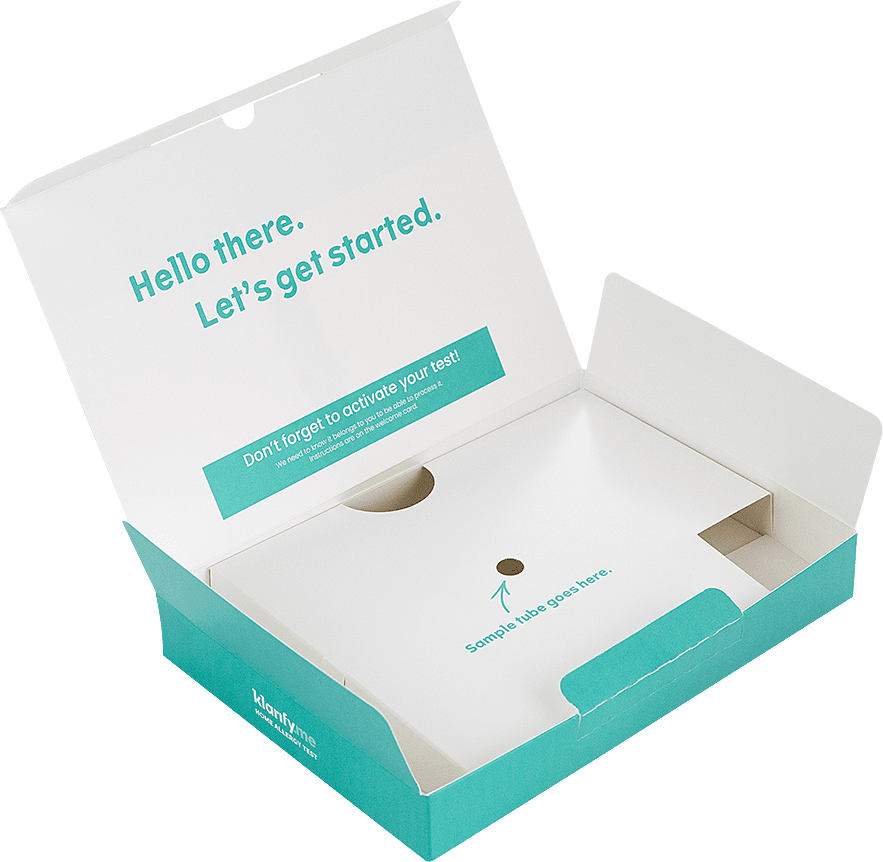
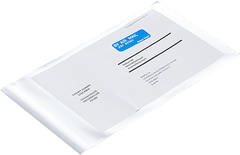


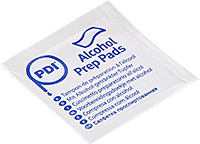
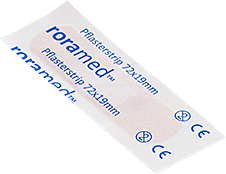
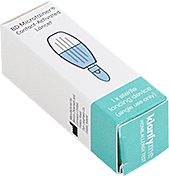


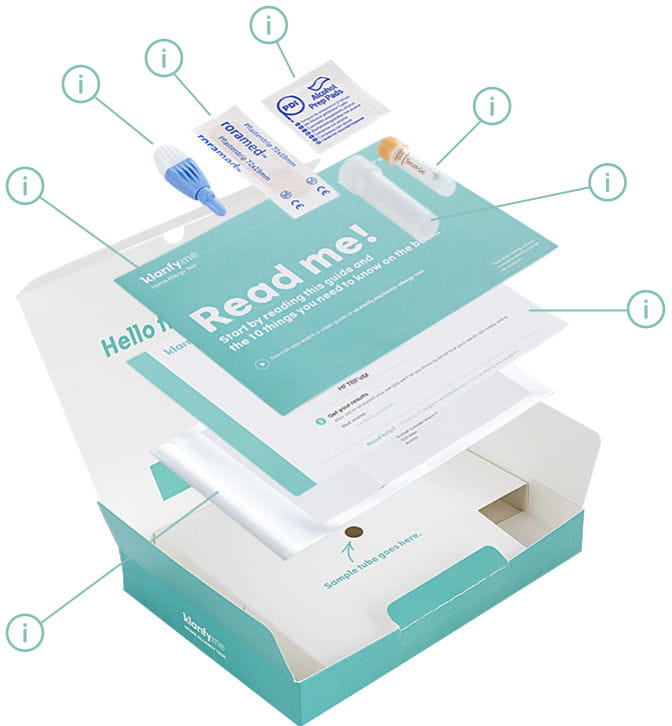
Why you should get tested for food allergy
Allergy tests can help you find out which triggers might be causing your symptoms and to rule out others. Think of the results of allergy testing as a sign of suspected allergy rather than clear cut proof.
Allergy test results alongside details of your symptoms and medical history can guide your doctor in creating a suitable treatment plan for you. Allergy tests can provide you with a risk profile of which allergen might be causing your symptoms.
One way to reduce the risk of an allergic reaction from a certain food is to identify the food that causes it and then try to avoid it. However, do not make any radical changes to your diet without first talking to your doctor or dietician.
Allergy blood can tests identify and measure specific IgE antibodies in your blood. As IgE antibodies are different depending on what they’re reacting to, allergy blood testing can indicate which allergens your body is reacting to.
Food allergy: a closer look
A food allergy is when your immune system overreacts to one or more foods. The allergic reaction usually occurs soon after eating a certain food. It involves a variety of chemicals to be released to fight the perceived danger. And it’s these chemicals that cause the allergic reaction. Nearly all foods can cause unpleasant allergic reactions. The foods that commonly cause an allergic reaction include:
- Milk
- Eggs
- Peanuts
- Tree nuts, i.e. almonds, walnuts etc
- Fish
- Shellfish
- Some fruits and vegetables
Food allergy or intolerance?
It can be easy to confuse food allergies with food intolerance as they can have some similar symptoms. Symptoms of both food intolerance and food allergy commonly affect the digestive, skin and respiratory systems. But the differences are significant.
Food intolerance doesn’t involve the immune system. Food intolerance often means you’re missing certain enzymes needed to fully digest a certain food. Food intolerance can also be caused by a substance within the food itself.
There are no blood tests used to diagnose food intolerance. Testing for food intolerances is often done with a trial elimination diet. Food intolerance is never a risk to life but if your food allergy is severe, it can be very serious.
Food allergy: what now?
An effective way to manage your food allergy is to remove the particular food from your diet. The Home Allergy Test can help you identify your triggers so you and can discuss with your doctor or dietitian which food or foods to try to avoid. It’s important to check with your doctor before you eliminate any food from your diet.
A blood allergy test alone won’t tell you if you have food allergies. A blood allergy test which detects IgE can indicate if you have sensitisation to any of the substances tested. An accurate diagnosis requires both a test and a consultation with your doctor. Your medical history is the fundamental link between your test results and being diagnosed.
Others say
"Very clear instructions and the packaging is high quality. Looking forward to receiving the results." - Sara P
"I got the results and I have to say, I am very impressed.
I have only ever noticed suffering from sensitivity to cats, dust and a bit on grass before moving house at the end of Feb and I’ve always been able to control these reactions with off the shelf antihistamine, the test confirmed sensitivity to all of these.
Since moving I have suffered badly from a far more severe reaction to something unknown, I had assumed it was pollen from the symptoms as I am now surrounded by trees and flowering plants and there is a park behind the house, so plenty of grass too. My hope when taking the test was to find out if this new issue was a general sensitivity or if there was something specific in my new environment which was causing it. I am delighted that the test came back with such a strong positive on Ash tree pollen along with a moderate on Olive (which as I’m reading are in some way connected) while showing no sensitivity to other tree pollen types at all.
Having checked the pollen season for Ash trees it seems to coincide really well with when I had my symptoms, I.e. through March and April I was really bad but its clearing up now in May to the point that its negligible now. Looking around outside I think I’ve spotted the culprit at the back of my garden right next to where I’ve been sitting when outside!
I was sceptical about spending the money on this but at the time my symptoms were so harsh I think I’d have tried almost anything! I’m so glad that I did this now." - Rob S.
"Great product! For a while now, I have suspected that my son might have an allergy. I was leaning towards tree or grass pollen, but he didn’t really seem to be consistently bothered when being outside. I bought the home allergy test to understand what he was sensitised to. The guide that comes with the product, made it a simple exercise to complete the test. Drawing the blood took about 20 seconds, and there is really little hassle at all.
The report came back within a couple of weeks and showed high sensitisation to house dust mite. Didn’t think of that beforehand. So now we know where to focus and we have had dialogue with our doctor for next steps and proper treatment." - Morten S.

